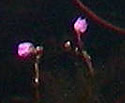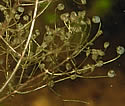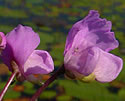Utricularia purpurea (Purple-flowered Bladderwort)
| Also known as: | |
|---|---|
| Genus: | Utricularia |
| Family: | Lentibulariaceae (Bladderwort) |
| Life cycle: | perennial |
| Origin: | native |
| Status: |
|
| Habitat: | sun; lakes, usually in shallower water near a boggy shoreline |
| Bloom season: | July - September |
| Plant height: | 1 to 6 inches |
| Wetland Indicator Status: | GP: none MW: OBL NCNE: OBL |
| MN county distribution (click map to enlarge): |  |
| National distribution (click map to enlarge): |  |
Pick an image for a larger view. See the glossary for icon descriptions.
Detailed Information
Flower: 

![[photo of flowers (not fully open)]](/udata/r9ndp23q/pd/utricularia-purpurea-7980-6-t.jpg) Raceme bearing 1 to 4 pinkish-purple, snapdragon-like flowers at the top of a naked maroon stem emerging 2 to 5 inches out of the water. Flowers are 1/3 to ½ inch long, the lower lip when fully extended is 3-lobed, white at the base with a spot of yellow in the center. The upper lip is rather shorter than but nearly as wide as the lower lip. A curved spur is present below the lower lip that is yellowish to white and shorter than the lower lip.
Raceme bearing 1 to 4 pinkish-purple, snapdragon-like flowers at the top of a naked maroon stem emerging 2 to 5 inches out of the water. Flowers are 1/3 to ½ inch long, the lower lip when fully extended is 3-lobed, white at the base with a spot of yellow in the center. The upper lip is rather shorter than but nearly as wide as the lower lip. A curved spur is present below the lower lip that is yellowish to white and shorter than the lower lip.
Leaves and stems: 

![[photo of leaves with bladders]](/udata/r9ndp23q/pd/utricularia-purpurea-78324697-12-t.jpg) Stems and leaves are submerged and free-floating. Roots do not develop. Leaves occur in whorls of 5 to 7 with bladders at the tips of leaves. Turions (overwintering vegetative buds) develop on branch tips in the early fall. Stems may grow to 3 feet long.
Stems and leaves are submerged and free-floating. Roots do not develop. Leaves occur in whorls of 5 to 7 with bladders at the tips of leaves. Turions (overwintering vegetative buds) develop on branch tips in the early fall. Stems may grow to 3 feet long.
Fruit: 
Fruit is a round capsule.
Notes:
Purple-flowered Bladderwort is the rarest Utricularia in Minnesota. According to the DNR, it was first observed in 1992 and has since only been located in fewer than a dozen lakes. It was listed as a Special Concern species in 1996 and elevated to Endangered in 2013, the primary threat being development that would alter water chemistry and degrade its aquatic habitat. When in bloom it could only be confused with Lavender Bladderwort (Utricularia resupinata), our other purple-flowered Bladderwort, but U. purpurea can easily be distinguished from all other Utricularia species in Minnesota by its whorled leaves and bladders at the leaf tips. Although the commonly held view is that the bladders of bladderworts are for capturing and digesting microorganisms that provide the plant with nutrients, bladders more often have been observed to contain communities of microorganisms (bacteria, algae, and diatoms) living in the bladders, not as prey, suggesting that the bladders may also, and perhaps more importantly, serve to establish mutually beneficial relationships with some microorganisms.
Native Plant Nurseries, Restoration and Landscaping Services ↓
More photos
 Purple-flowered Bladderwort plants
Purple-flowered Bladderwort plants Purple-flowered Bladderwort habitat
Purple-flowered Bladderwort habitat leaves just below the water surface
leaves just below the water surface more leaves
more leaves more flowers (not fully open)
more flowers (not fully open)
Photos courtesy Peter M. Dziuk taken in Pine County.
Comments
Have you seen this plant in Minnesota, or have any other comments about it?
on: 2023-08-24 15:27:28
Not sure this is what we saw. Couldn't get close, but saw a small patch of it along the shore line between a couple stands of bullrush. It was blooming pretty pink flowers in late August.
on: 2023-08-24 15:46:19
Joanne, neither of the pink/purple Utricularia species in MN has been recorded in Hubbard County. It would be a sweet find it that is indeed what you saw.






